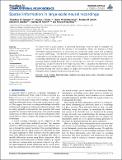| dc.contributor.author | Cybulski, Thaddeus R. | |
| dc.contributor.author | Glaser, Joshua I. | |
| dc.contributor.author | Zamft, Bradley M. | |
| dc.contributor.author | Kording, Konrad P. | |
| dc.contributor.author | Marblestone, Adam Henry | |
| dc.contributor.author | Church, George M | |
| dc.contributor.author | Boyden, Edward | |
| dc.date.accessioned | 2015-02-11T17:10:47Z | |
| dc.date.available | 2015-02-11T17:10:47Z | |
| dc.date.issued | 2015-01 | |
| dc.date.submitted | 2014-02 | |
| dc.identifier.issn | 1662-5188 | |
| dc.identifier.uri | http://hdl.handle.net/1721.1/94329 | |
| dc.description.abstract | To record from a given neuron, a recording technology must be able to separate the activity of that neuron from the activity of its neighbors. Here, we develop a Fisher information based framework to determine the conditions under which this is feasible for a given technology. This framework combines measurable point spread functions with measurable noise distributions to produce theoretical bounds on the precision with which a recording technology can localize neural activities. If there is sufficient information to uniquely localize neural activities, then a technology will, from an information theoretic perspective, be able to record from these neurons. We (1) describe this framework, and (2) demonstrate its application in model experiments. This method generalizes to many recording devices that resolve objects in space and should be useful in the design of next-generation scalable neural recording systems. | en_US |
| dc.description.sponsorship | Hertz Foundation | en_US |
| dc.description.sponsorship | United States. Office of Naval Research | en_US |
| dc.description.sponsorship | National Human Genome Research Institute (U.S.). Centers of Excellence in Genomic Science | en_US |
| dc.description.sponsorship | Allen Institute for Brain Science | en_US |
| dc.description.sponsorship | AT&T | en_US |
| dc.description.sponsorship | Google (Firm) | en_US |
| dc.description.sponsorship | Institution of Engineering and Technology (A. F. Harvey Prize) | en_US |
| dc.description.sponsorship | McGovern Institute for Brain Research at MIT. Neurotechnology (MINT) Program | en_US |
| dc.description.sponsorship | McGovern Institute for Brain Research at MIT | en_US |
| dc.description.sponsorship | Massachusetts Institute of Technology. Media Laboratory | en_US |
| dc.description.sponsorship | MIT Media Lab Consortium | en_US |
| dc.description.sponsorship | New York Stem Cell Foundation (Robertson Investigator Award) | en_US |
| dc.description.sponsorship | National Institutes of Health (U.S.). Pioneer Award (1DP1NS087724) | en_US |
| dc.description.sponsorship | National Institutes of Health (U.S.). Transformative Award (1R01MH103910) | en_US |
| dc.description.sponsorship | National Institutes of Health (U.S.). Transformative Award (1R01GM104948) | en_US |
| dc.description.sponsorship | National Science Foundation (U.S.) (INSPIRE Award CBET 1344219) | en_US |
| dc.description.sponsorship | Paul G. Allen Family Foundation. Distinguished Investigator in Neuroscience Award | en_US |
| dc.description.sponsorship | Skolkovo Institute of Science and Technology | en_US |
| dc.description.sponsorship | Massachusetts Institute of Technology. Synthetic Intelligence Laboratory | en_US |
| dc.language.iso | en_US | |
| dc.publisher | Frontiers Research Foundation | en_US |
| dc.relation.isversionof | http://dx.doi.org/10.3389/fncom.2014.00172 | en_US |
| dc.rights | Creative Commons Attribution | en_US |
| dc.rights.uri | http://creativecommons.org/licenses/by/4.0/ | en_US |
| dc.source | Frontiers Research Foundation | en_US |
| dc.title | Spatial information in large-scale neural recordings | en_US |
| dc.type | Article | en_US |
| dc.identifier.citation | Cybulski, Thaddeus R., Joshua I. Glaser, Adam H. Marblestone, Bradley M. Zamft, Edward S. Boyden, George M. Church, and Konrad P. Kording. “Spatial Information in Large-Scale Neural Recordings.” Frontiers in Computational Neuroscience 8 (January 21, 2015). | en_US |
| dc.contributor.department | Massachusetts Institute of Technology. Department of Biological Engineering | en_US |
| dc.contributor.department | Massachusetts Institute of Technology. Media Laboratory | en_US |
| dc.contributor.department | McGovern Institute for Brain Research at MIT | en_US |
| dc.contributor.department | Program in Media Arts and Sciences (Massachusetts Institute of Technology) | en_US |
| dc.contributor.mitauthor | Boyden, Edward Stuart | en_US |
| dc.contributor.mitauthor | Marblestone, Adam Henry | en_US |
| dc.contributor.mitauthor | Church, George M. | en_US |
| dc.relation.journal | Frontiers in Computational Neuroscience | en_US |
| dc.eprint.version | Final published version | en_US |
| dc.type.uri | http://purl.org/eprint/type/JournalArticle | en_US |
| eprint.status | http://purl.org/eprint/status/PeerReviewed | en_US |
| dspace.orderedauthors | Cybulski, Thaddeus R.; Glaser, Joshua I.; Marblestone, Adam H.; Zamft, Bradley M.; Boyden, Edward S.; Church, George M.; Kording, Konrad P. | en_US |
| dc.identifier.orcid | https://orcid.org/0000-0002-0419-3351 | |
| mit.license | PUBLISHER_CC | en_US |
| mit.metadata.status | Complete | |
